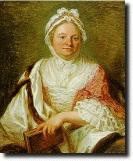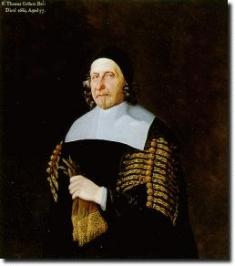|
| |
 |
|
|
(Below): Susannah, wife of Sir John Cullum, 5th Baronet, by Angelica Kauffmann, 1772 
(Below): George Gery Milner-Gibson Cullum, by Charles Forbes, 1885. 
|
The Cullum family owned the Hardwick and Hawstead estates on the outskirts of Bury St. Edmunds. They were purchased in 1656 by Sir Thomas Cullum (1590-1664) first Baronet, a wealthy London draper knighted by Charles II in recognition of his services to the Royalist cause.  (Above): Sir Thomas Cullum, 1st Baronet, attributed to Gerard Soest, c. 1660. The last surviving member George Gery Milner-Gibson Cullum, died unmarried in 1921. A former Mayor of Bury St. Edmunds, he had been instrumental in establishing Moyse's Hall as the borough's first museum, and had loaned a number of his family possessions for display. He died without an heir, and a legal technicality prevented him from bequeathing the estate as he chose, and so he decided to bequeath the collection on display in Moyse's Hall to the borough. In addition he presented many other family heirlooms, including most of.the portraits, china and other objets d'art; his extensive library of books - chiefly of genealogy and local history - was also bequeathed to the town and is now housed in the West Suffolk Record Office. The family portraits span the seventeenth to twentieth centuries and include notable works by several leading British artists. The portraits of Sir Thomas Cullum, second Baronet (1633-1680) and his wife Dudley are by Sir Peter Lely, portrait painter to the Court of Charles 11. The artist's sensitive depiction of this couple conveys the dissolute and selfish nature of Sir Thomas, and the melancholy character of Dudley who suffered from bouts of extreme depression. It is therefore no surprise that according to the surviving family papers they suffered a very unhappy marriage.  (Above): Dudley, wife of Sir Thomas Cullum, 2nd Baronet, by Sir Peter Lely, c. 1660. Notable eighteenth-century portraits include those of the Reverend Sir John Cullum, sixth Baronet (1733-1785) and his mother Susannah by Angelica Kauffmann. Sir John was the most scholarly member of what was, in this period, a very scholarly family and he was elected a Fellow of the Society of Antiquaries and the Royal Society. A keen botanist and genealogist, he published the History of Hawstead in 1785. A contemporary letter records that he objected to the cap that Dame Susannah, his mother, had chosen to wear for her portrait sittings, but her choice was exonerated by the artist: '. . . (Miss Kauffmann) says she likes the going of the cap extremely well and that it is as becoming a Head Dress for a person of my Mother's Age (this very day 60) as can be . . .' The most distinguished nineteenth-century family portrait depicts Sydney Milner-Gibson, granddaughter of the Reverend Sir John Gery Cullum the 8th and last Baronet. It was commissioned in 1871 by Thomas Bowles, half-brother of Sydney, from his friend the French artist James Tissot (1836-1902). Tissot had recently been obliged to flee from Paris following the ravages caused by the Franco-Prussian War and, settled in his friend Bowles' house in London, was eager for portrait work. On completion iii the spring of 1872 it was presented to Sydney as a twenty-first birthday present. Sadly she died, unmarried, of tuberculosis when she was only thirty-one. Cullum family watercolours and miniatures are also on display. For the first time since being bequeathed in 1921 the portraits are displayed in one building as the donor intended. Other paintings given by George Cullum include two early naive views of the Market Place, c. 1700, and items picked up on his travels in Europe, notably a pair of Bacchanals attributed to the seventeenth-century Neapolitan artist Luca di Giordano, but now thought to be by his lesser contemporary Paolo de Matteis.  (Above): Sydney Milner-Gibson, by James Tissot, 1872 |
